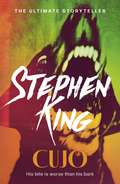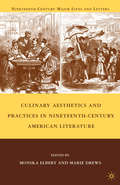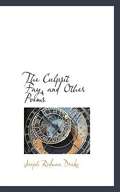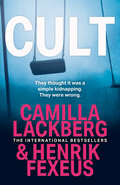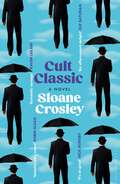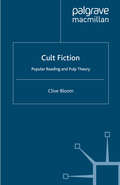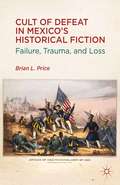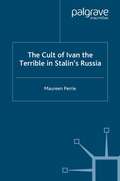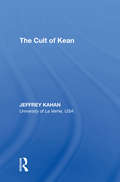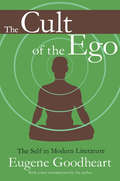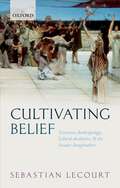- Table View
- List View
Cuff Me (New York's Finest #3)
by Lauren LayneMeet New York's Finest-three hot brothers sworn to protect and serve the city they love . . . and the women who've stolen their hearts.ARRESTED BY LOVEVincent Moretti is one of the NYPD's top homicide detectives-and one of the most eligible bachelors in town. His family, however, thinks he should date his longtime partner, Jill-a sassy, sexy, smart-mouthed blonde who drives him absolutely crazy.Behind the quiet authority, tough-guy demeanor, and dark aviator glasses lies a man with a big soul-and a hard body that can soften any girl's heart. After years as his coworker, Jill Henley has given up hope that anything could happen between her and Vin. Besides, loving him would break all the rules. But seeing Jill with someone else triggers feelings in Vincent he never knew he had. Now he'll have to stop playing good cop/bad cop-and find a way to convince her to be his partner for life. . .
Cuffs: Cuffs / Holiday Hookup (Mills And Boon Dare Ser.)
by Cara LockwoodSome opposites don't just attract They burn
Cuffs / Holiday Hookup: Cuffs / Holiday Hookup (Mills And Boon Dare Ser.)
by Cara Lockwood Jamie K. SchmidtWhen opposites attract…and burn Tattoo artist Mags McHenry doesn't believe in love. But when a gorgeous banker steps into her shop, Mags knows she believes in lust…and a desire to submit to Gael Quinn's commanding touch. Gael is everything she craves. And everything she hates. So why is Mags falling for him?
Cugel: The Skybreak Spatterlight (The Dying Earth #3)
by Jack VanceThe fantastic quests and adventures of Cugel: the greatest rogue in the realms of fantasy. For the second time, Cugel the Clever has been carried north over the Ocean of Sighs and dumped half a world away from home, on Shanglestone Strand. Swearing revenge on the Laughing Magician, Cugel sets off through mud pits and bars, through villages, manor houses and across the seas. At last, after many an extraordinary adventure, he comes once more to the land of Almery and the chance to exact the vengeance he craves . . .
Cugel the Clever (Gateway Essentials)
by Jack VanceIn the dim far future of Earth, when the sun had shrunk to a small red disk in the dark sky and the race of man lived in isolated cities that echoed with the vastness of the world's history, science, myth and magic had become one. Sorcerors who read the books of ancient times held great power, and fearsome monsters created in ages long forgotten stalked the land. In this world of mystery and danger, the adventurer known as Cugel the Clever was forced to undertake a quest for Iucounu the Laughing Magician - a quest that was to take him to lands stranger than any he had dreamed of, and pit his wits and his sword against powers from beyond time itself.Previously published as The Eyes of the Overworld, this is the second of a quartet of titles sharing the same far-future setting first introduced in The Dying EarthContents: The Overworld, Cil, The Mountains of Magnatz, The Sorcerer Pharesm, The Pilgrims, The Cave in the Forest, The Manse of Iucounu.All Jack Vance titles in the SFGateway use the author's preferred texts, as restored for the Vance Integral Edition (VIE), an extensive project masterminded by an international online community of Vance's admirers. In general, we also use the VIE titles, and have adopted the arrangement of short story collections to eliminate overlaps.
Cuibhle an Fhortain
by Mòrag LawAn Dàn – caochladach, dìomhair is uaireanan gu math cruaidh. Cò nar measg nach do dh’ fhuiling buaidh An Dàn air ar beatha? Bho fàsaichean Àstrailia gu na h-Innse Gall, bho taigheadas seann dhaoine gu casino anns a’ bhaile mhòr tha an cruinneachadh seo a’ sealltainn dhuinn làmh An Dàin ag obair ann am beathannan agus anns na dàimhean caochladh charactaran. Buidheann sgrìobhadairean ag ionnsachadh leasan ùr iongantach , cupall a’ dèiligeadh ri laigse na h-aoise. Pàrantan a’ strì ri thuigsinn inbheachd ùr an nighean ,fear a’ dèanamh bargan nach eil ag obrachadh a-mach ann an dòigh san robh dùil aige. Ann an cuid de na sgeulachdan bidh caractaran a’ tachradh ris An Dàn ann an cumadh strainnsear no neach-tadhail aig nach robh dùil aca. Tha sgeulachdan ann far a bheil An Dàin a’ tighinn am follais ann an tachartasan sònraichte agus cuid eile far a bheil caractaran a’ feuchainn ri cothachadh leis a’ bhuaidh ‘s a tha An Dàin a’ fàgail orra bho na làithean a dh’fhalbh. Gu tric bi iad gar fàgail le ceistean mun àm ri teachd, ‘ s iad uile a’ cuir cuideam air dè cho mi-chìnnteach ‘s a tha beatha mac an duine, far nach eil fhios aig duin’ againn dè tha air thoisich oirnn. Fate – fickle, mysterious and sometimes very cruel. From the outback of Australia to the Hebrides, from a city casino to the confines of sheltered housing, this collection of stories shows the hand of Fate at work in the lives and relationships of a wide variety of characters. There are the members of a writers’ group who learn a new and surprising lesson, a couple coming to terms with the restrictions of age, parents forced to acknowledge the growing maturity of their child, a man who makes a bargain with unforeseen results. In some stories, the characters encounter Fate in the guise of a stranger or unexpected visitor, or while experiencing significant – sometimes life-changing – events. In others, the characters are facing up to the effects of a fateful experience in their past. All the stories will leave you with as many questions as answers and make you think anew about the effect of Fate on all our lives.
Cujo: A Novel (Collections Litterature Ser. #Vol. 6001333)
by Stephen KingOnce upon a time, not so long ago, a monster came to the small town of Castle Rock, Maine . . . He was not a werewolf, vampire, ghoul, or unnameable creature from the enchanted forest or snow wastes; he was only a cop . . . Cujo is a huge Saint Bernard dog, the best friend Brett Camber has ever had. Then one day Cujo chases a rabbit into a bolt-hole. Except it isn't a rabbit warren any more. It is a cave inhabited by rabid bats.And Cujo falls sick. Very sick. And the gentle giant who once protected the family becomes a vortex of horror inexorably drawing in all the people around him . . .
Culinary Aesthetics and Practices in Nineteenth-Century American Literature (Nineteenth-Century Major Lives and Letters)
by M. Drews M. ElbertCulinary Aesthetics and Practices in Nineteenth-Century American Literature examines the preponderance of food imagery in nineteenth-century literary texts. Contributors to this volume analyze the social, political, and cultural implications of scenes involving food and dining and illustrate how "aesthetic" notions of culinary preparation are often undercut by the actual practices of cooking and eating. As contributors interrogate the values and meanings behind culinary discourses, they complicate commonplace notions about American identity and question the power structure behind food production and consumption.
The Cull: An action-packed and full-throttle thriller (Sonja Kurtz #3)
by Tony Park'No modern author writes with as much knowledge, conviction and love of the Southern Africa of today as Aussie veteran army officer Tony Park' Crime ReviewThe war to save Africa’s wildlife is fought on many fronts.For former mercenary Sonja Kurtz the opportunity to head up an elite squad tasked with taking down the continent’s poaching kingpins is a chance to strike at the heart of the enemy. Financed by British billionaire Julianne Clyde-Smith, the pair hope to bring about real change.But as their operation progresses, the new unit’s activities soon draws them into the firing line of The Scorpions. A ruthless underworld syndicate willing to do anything to protect their bloodthirsty trade.When Sonja’s love interest, safari guide and private detective Hudson Brand, is employed to investigate the death of an alleged poacher at the hands of the team, their mission comes under intense scrutiny. As darker forces come into play and the body count rises, Sonja is forced to consider if Julianne’s crusade has gone too far and what she could lose if she continues with the increasingly bloody campaign . . .
The Culprit Fay, and Other Poems
by Joseph Rodman DrakeJoseph Rodman Drake (1795-1820) was an early American poet. Born in New York City, he was orphaned when young and entered a mercantile house. While still a child, he showed a talent for writing poems. He was educated at Columbia. In 1813 he began studying in a physician's office. In 1816 he began to practice medicine and in the same year was married to Sarah, daughter of Henry Eckford, the naval architect. In 1819, together with his friend and fellow poet Fitz-Greene Halleck, he wrote a series of satirical verses for the New York Evening Post, which were published under the penname The Croakers. Drake died a year later, of consumption, at the age of twenty-five. A collection, The Culprit Fay and Other Poems, was published posthumously by his daughter in 1835. His best-known poems are the long title-poem of that collection, and the patriotic The American Flag.
The Cult
by Abby DaviesThe gripping new thriller that will have you on the edge of your seat from the first page to the last!
Cult (Mina Dabiri and Vincent Walder #2)
by Camilla Läckberg Henrik FexeusA thriller that will have you on the edge of your seat from the first page to the last!
Cult Classic
by Sloane Crosley'The witty, improbably propulsive rom-com you didn't know you were waiting for' ELIF BATUMAN'Razor sharp and very funny on the cult of modern dating' PANDORA SYKES'So good. I couldn't stop reading it' NICK HORNBY'Cult Classic makes an uproarious time of romantic carnage' RAVEN LEILANI'A witty and fantastical story of dating and experimental psychology in New York City' PUBLISHERS WEEKLY (starred review)One night in New York City's Chinatown, Lola is at a dinner with former colleagues when she excuses herself to buy a pack of cigarettes. On her way back, she runs into a former boyfriend. The next night, she runs into another ex. And then… another. The city has become awash with ghosts of heartbreaks past. What might have passed for coincidence becomes something far stranger when the recently engaged Lola must contend not only with the viability of her current relationship, but the fact that her best friend and her former boss – a magazine editor turned mystical guru – might have an unhealthy investment in its outcome. As memories of the past swirl and converge, Lola is forced to decide if she will surrender herself to the conspirings of one very contemporary cult. A smart, sharp and hugely entertaining tale of luck and love, Cult Classic asks: is it possible to have a happy ending in an age when the past is ever at your fingertips and sanity is for sale?
Cult Classic
by Sloane Crosley'The witty, improbably propulsive rom-com you didn't know you were waiting for' ELIF BATUMAN'Razor sharp and very funny on the cult of modern dating' PANDORA SYKES'So good. I couldn't stop reading it' NICK HORNBY'Cult Classic makes an uproarious time of romantic carnage' RAVEN LEILANI'A witty and fantastical story of dating and experimental psychology in New York City' PUBLISHERS WEEKLY (starred review)One night in New York City's Chinatown, Lola is at a dinner with former colleagues when she excuses herself to buy a pack of cigarettes. On her way back, she runs into a former boyfriend. The next night, she runs into another ex. And then… another. The city has become awash with ghosts of heartbreaks past. What might have passed for coincidence becomes something far stranger when the recently engaged Lola must contend not only with the viability of her current relationship, but the fact that her best friend and her former boss – a magazine editor turned mystical guru – might have an unhealthy investment in its outcome. As memories of the past swirl and converge, Lola is forced to decide if she will surrender herself to the conspirings of one very contemporary cult. A smart, sharp and hugely entertaining tale of luck and love, Cult Classic asks: is it possible to have a happy ending in an age when the past is ever at your fingertips and sanity is for sale?
Cult Fiction: Popular Reading and Pulp Theory
by C. BloomHere is an exploration of pulp literature and pulp mentalities: an investigation into the nature and theory of the contemporary mind in art and in life. Here too, the violent, the sensational and the erotic signify different facets of the modern experience played out in the gaudy pages of kitsch literature. Clive Bloom offers the reader a chance to investigate the underworld of literary production and from it find a new set of co-ordinates for questions regarding publishing and reading practices in America and Britain, ideas of genre, problems related to commercial production, concerns regarding high and low culture, the canon and censorship, as well as a discussion of the rhetoric of current critical debate. Concentrating on remembered authors as well as many long disregarded or forgotten, Cult Fiction provides a theory of kitsch art that radically alters our perceptions of literature and literary values whilst providing a panorama of an almost forgotten history: the history of pulp.
Cult of Defeat in Mexico’s Historical Fiction: Failure, Trauma, and Loss
by B. PriceCult of Defeat in Mexico's Historical Fiction: Failure, Trauma, and Loss examines recent Mexican historical novels that highlight the mistakes of the nineteenth century for the purpose of responding to present crises.
The Cult of Ivan the Terrible in Stalin's Russia (Studies in Russian and East European History and Society)
by M. PerrieIvan IV, the sixteenth-century Russian tsar notorious for his reign of terror, became an unlikely national hero in the Soviet Union during the 1940s. This book traces the development of Ivan's positive image, placing it in the context of Stalin's campaign for patriotism. In addition to historians' images of Ivan, the author examines literary and artistic representations, including Sergei Eisenstein's famous film, banned for its depiction of the tsar which was interpreted as an allegorical criticism of Stalin.
The Cult of Kean
by Jeffrey KahanA Shakespearean actor who made his career on the public stage, whose sex life was known and discussed in Britain, America and France, Edmund Kean has inspired numerous writings, many biographies among them. But until now, no work has tackled the complicated and fascinating story of his literary appropriation, both in his own day and after his death. Dealing with the way a variety of canonical authors-including Byron, Coleridge, Keats, Dumas, Twain and Sartre-appropriated Kean through the centuries, The Cult of Kean traces a remarkable literary legacy. In each chapter Jeffrey Kahan discusses how many of history's greatest figures viewed Kean, and how these figures examined and discussed themselves in relation to-or projected themselves onto-a variety of constructions of the great actor. Kahan first explores the rise of Kean in light of rising democratic sympathies, then in light of Kean's equally autocratic dealings with playwrights, among them John Keats. He looks at Kean's sexual shenanigans at Drury Lane, exploring them in the wider social context of infidelity; and explores perceptions of Kean in America, during his 1820-1 and 1825-6 tours. The Cult of Kean cites many letters from Kean's mother and still others from his wife, none of which have been published previously. The study also features rare and interesting paintings of Kean, as well as depictions of how writers, actors and film makers continue to add to his remarkable literary legacy.
The Cult of Kean
by Jeffrey KahanA Shakespearean actor who made his career on the public stage, whose sex life was known and discussed in Britain, America and France, Edmund Kean has inspired numerous writings, many biographies among them. But until now, no work has tackled the complicated and fascinating story of his literary appropriation, both in his own day and after his death. Dealing with the way a variety of canonical authors-including Byron, Coleridge, Keats, Dumas, Twain and Sartre-appropriated Kean through the centuries, The Cult of Kean traces a remarkable literary legacy. In each chapter Jeffrey Kahan discusses how many of history's greatest figures viewed Kean, and how these figures examined and discussed themselves in relation to-or projected themselves onto-a variety of constructions of the great actor. Kahan first explores the rise of Kean in light of rising democratic sympathies, then in light of Kean's equally autocratic dealings with playwrights, among them John Keats. He looks at Kean's sexual shenanigans at Drury Lane, exploring them in the wider social context of infidelity; and explores perceptions of Kean in America, during his 1820-1 and 1825-6 tours. The Cult of Kean cites many letters from Kean's mother and still others from his wife, none of which have been published previously. The study also features rare and interesting paintings of Kean, as well as depictions of how writers, actors and film makers continue to add to his remarkable literary legacy.
The Cult of Osiris (Wilde/Chase)
by Andy McDermottIn Andy McDermott's brilliant fifth novel, Nina Wilde and Eddie Chase are on the hunt for the lost pyramid of Osiris... Discredited, jobless and broke, archaeologist Nina Wilde and ex-SAS soldier Eddie Chase have problems of their own - until Macy's plea for help sends them on a deadly quest across the globe as they try to reach the mysterious pyramid before Khalid Osir, the charismatic leader of the Osirian Temple. But is the cult's motive purely greed... or something more sinister?
The Cult of the Ego: The Self in Modern Literature
by Eugene GoodheartGoethe once remarked that "every emancipation of the spirit is pernicious unless there is a corresponding growth of control." This remark may be taken as a motto for Eugene Goodheart's study of an aspect of the cultural history of the past two hundred years. In separate chapters on Rousseau, Stendhal, Goethe and Carlyle, Dostoevsky, Whitman, Lawrence, and Joyce, Goodheart discovers a community of concern which he calls the cult of the ego. All these writers examined here in one way or another deal with "the emancipation of the spirit" with all its promise and danger. The characteristic attempt is to "extend the boundaries of the self by going beyond the area of safety" and. thereby risking even the destruction of the self. They advance the claims of the self at the same time seeking the controls that will secure these claims. The artist-hero becomes the central figure in Goodheart's volume, since it is he who comes to exemplify the possibilities of the cult of the ego. Their efforts, Goodheart argues, have ambiguous results. The seeds of contemporary nihilism are in the failures of these writers to master the chaos of egoism, which they helped engender. But their heroism was partly in the effort of resistance: moral, religious, aesthetic. In a large portion of modern literature, resistance has been abandoned either out of exhaustion or out of fascination with the destructive tendency of modern life: in Beckett's phrase, "a world endlessly collapsing." In his introduction to this first paperback edition, Goodheart discusses the book's origin in relation to the counter-cultural unrest of 1968 when it was first published and weighs its theme of the emancipated self against current postmodern assertions of the "death of the author." The Cult of the Ego is written with admirable clarity and economy. Its interests are literary, moral and political. Moving freely and knowledgeably among various national literatures, Goodheart has made an original and valuable contribution to the field of comparative literature. Eugene Goodheart is Edytha Macy Gross Professor of Humanities Emeritus at Brandeis University. Among his books are Novel Practices: Classic Modern Fiction, Modernism and the Critical Spirit, Culture and the Radical Conscience, and Confessions of a Secular Jew: A Memoir, all available from Transaction.
The Cult of the Ego: The Self in Modern Literature
by Eugene GoodheartGoethe once remarked that "every emancipation of the spirit is pernicious unless there is a corresponding growth of control." This remark may be taken as a motto for Eugene Goodheart's study of an aspect of the cultural history of the past two hundred years. In separate chapters on Rousseau, Stendhal, Goethe and Carlyle, Dostoevsky, Whitman, Lawrence, and Joyce, Goodheart discovers a community of concern which he calls the cult of the ego. All these writers examined here in one way or another deal with "the emancipation of the spirit" with all its promise and danger. The characteristic attempt is to "extend the boundaries of the self by going beyond the area of safety" and. thereby risking even the destruction of the self. They advance the claims of the self at the same time seeking the controls that will secure these claims. The artist-hero becomes the central figure in Goodheart's volume, since it is he who comes to exemplify the possibilities of the cult of the ego. Their efforts, Goodheart argues, have ambiguous results. The seeds of contemporary nihilism are in the failures of these writers to master the chaos of egoism, which they helped engender. But their heroism was partly in the effort of resistance: moral, religious, aesthetic. In a large portion of modern literature, resistance has been abandoned either out of exhaustion or out of fascination with the destructive tendency of modern life: in Beckett's phrase, "a world endlessly collapsing." In his introduction to this first paperback edition, Goodheart discusses the book's origin in relation to the counter-cultural unrest of 1968 when it was first published and weighs its theme of the emancipated self against current postmodern assertions of the "death of the author." The Cult of the Ego is written with admirable clarity and economy. Its interests are literary, moral and political. Moving freely and knowledgeably among various national literatures, Goodheart has made an original and valuable contribution to the field of comparative literature. Eugene Goodheart is Edytha Macy Gross Professor of Humanities Emeritus at Brandeis University. Among his books are Novel Practices: Classic Modern Fiction, Modernism and the Critical Spirit, Culture and the Radical Conscience, and Confessions of a Secular Jew: A Memoir, all available from Transaction.
Cultivating Belief: Victorian Anthropology, Liberal Aesthetics, and the Secular Imagination
by Sebastian LecourtThis book explores how a group of Victorian liberal writers that included George Eliot, Walter Pater, and Matthew Arnold became attracted to new theories of religion as a function of race and ethnicity. Since the early modern period, British liberals had typically constructed religion as a zone of personal belief that defined modern individuality and interiority. During the 1860s, however, Eliot, Arnold, and other literary liberals began to claim that religion could actually do the most for the modern self when it came as a kind of involuntary inheritance. Stimulated by the emerging science of anthropology, they imagined that religious experiences embedded in race or ethnicity could render the self heterogeneous, while the individual who insisted upon selecting his or her own beliefs would become narrow and parochial. By rethinking the grounds of religion, this book argues, these writers were ultimately trying to shift liberal individualism away from a classical Protestant liberalism that celebrated interiority and agency and toward one that valorized eclecticism and the capacity to keep multiple values in play. More broadly, their work offers us a new picture of secularization, not as a process of religious decline, but as the reinscription of religion as an ordinary feature of human life—like art, or politics, or sex—whose function could be debated.
Cultivating Belief: Victorian Anthropology, Liberal Aesthetics, and the Secular Imagination
by Sebastian LecourtThis book explores how a group of Victorian liberal writers that included George Eliot, Walter Pater, and Matthew Arnold became attracted to new theories of religion as a function of race and ethnicity. Since the early modern period, British liberals had typically constructed religion as a zone of personal belief that defined modern individuality and interiority. During the 1860s, however, Eliot, Arnold, and other literary liberals began to claim that religion could actually do the most for the modern self when it came as a kind of involuntary inheritance. Stimulated by the emerging science of anthropology, they imagined that religious experiences embedded in race or ethnicity could render the self heterogeneous, while the individual who insisted upon selecting his or her own beliefs would become narrow and parochial. By rethinking the grounds of religion, this book argues, these writers were ultimately trying to shift liberal individualism away from a classical Protestant liberalism that celebrated interiority and agency and toward one that valorized eclecticism and the capacity to keep multiple values in play. More broadly, their work offers us a new picture of secularization, not as a process of religious decline, but as the reinscription of religion as an ordinary feature of human life—like art, or politics, or sex—whose function could be debated.






